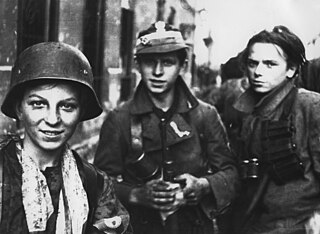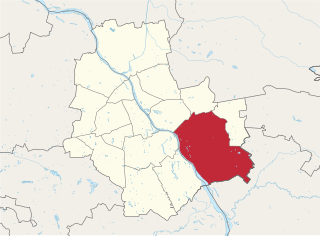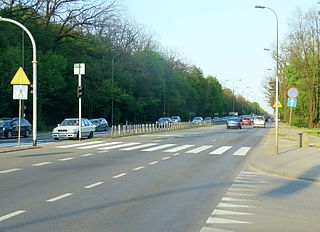
Praga is a district of Warsaw, Poland. It is on the east bank of the river Vistula. First mentioned in 1432, until 1791 it formed a separate town with its own city charter.

Zgierz is a city in central Poland, located just to the north of Łódź, and part of the metropolitan area centered on that city. As of 2021, it had a population of 54,974. Located within the historic Łęczyca Land, it is the capital of Zgierz County in the Łódź Voivodeship.

Around six million Polish citizens are estimated to have perished during World War II. Most were civilians killed by the actions of Nazi Germany, the Soviet Union, the Lithuanian Security Police, as well as the Organization of Ukrainian Nationalists and its offshoots.

Kedyw (Polish pronunciation:[ˈkɛdɨf], partial acronym of Kierownictwo Dywersji was a Polish World War II Home Army unit that conducted active and passive sabotage, propaganda and armed operations against Nazi German forces and collaborators.

The kotwica was an emblem of the Polish Underground State and Armia Krajowa used during World War II. It was created in 1942 by members of the Wawer minor sabotage unit within the AK, as an easily usable emblem for the struggle to regain the country's independence. The initial meaning of the initialism PW was "pomścimy Wawer", in reference to the 1939 Wawer massacre, which was considered to be one of the first large scale massacres of Polish civilians by German troops in occupied Poland.

The underground courts were World War II secret courts in occupied Poland, organized by the Polish government-in-exile. The courts determined punishments for citizens of Poland who were subject to Polish law before the war.

"Grey Ranks" was a codename for the underground paramilitary Polish Scouting Association during World War II.

The Wola massacre was the systematic killing of between 40,000 and 50,000 Poles in the Wola neighbourhood of the Polish capital city, Warsaw, by the German Waffen-SS and fellow Axis collaborators in the Azerbaijani Legion, as well as the predominantly-Russian RONA forces, which took place from 5 to 12 August 1944. The massacre was ordered by Heinrich Himmler, who directed to kill "anything that moves" to stop the Warsaw Uprising soon after it began.

In Poland, the resistance movement during World War II was led by the Home Army. The Polish resistance is notable among others for disrupting German supply lines to the Eastern Front, and providing intelligence reports to the British intelligence agencies. It was a part of the Polish Underground State.

Rypin is a town in north-central Poland, in Kuyavian-Pomeranian Voivodeship, about 50 km east of Toruń. It is the capital of Rypin County. Population is 16,528 (2010).

Wawer is one of the districts of Warsaw, located in the south-eastern part of the city. The Vistula river runs along its western border. Wawer became a district of Warsaw on 27 October 2002.

A minor sabotage during World War II in Nazi-occupied Poland (1939–45) was any underground resistance operation that involved a disruptive but relatively minor and non-violent form of defiance, such as the painting of graffiti, the manufacture of fake documents, the disrupting of German propaganda campaigns, and the like. Minor-sabotage operations often involved elements of humor.
Operation Wieniec was a large-scale World War II anti-Nazi Home Army operation. It took place on the night of 7 to 8 October 1942, targeting rail infrastructure near Warsaw. Similar operations, aimed at disrupting German transport and communications in occupied Poland, occurred in subsequent months and years, targeting railroads, bridges and supply depots, primarily near transport hubs such as Warsaw and Lublin.
The Supreme National Tribunal was a war-crime tribunal active in communist-era Poland from 1946 to 1948. Its aims and purpose were defined by the State National Council in decrees of 22 January and 17 October 1946 and 11 April 1947. The new law was based on an earlier decree of 31 August 1944 issued by the new Soviet-imposed Polish regime, with jurisdiction over "fascist-Hitlerite criminals and traitors to the Polish nation". The Tribunal presided over seven high-profile cases involving a total of 49 individuals.
The massacres in Piaśnica were a series of mass murders carried out by Nazi Germany during World War II, between the fall of 1939 and spring of 1940 in Piaśnica Wielka in the Darzlubska Wilderness near Wejherowo. The exact number of people murdered is unknown, but estimates range between 12,000 and 14,000 victims. Most of them were Polish intellectuals from Gdańsk Pomerania, but Poles, Kashubians, Jews, Czechs and German inmates from mental hospitals from the General Government and the Third Reich were also murdered. After the Stutthof concentration camp, Piaśnica was the largest site of killings of Polish civilians in Pomerania by the Germans, and for this reason, is sometimes referred to as the "second" or "Pomeranian" Katyn. It was the first large-scale Nazi atrocity in occupied Poland.

The Wola Massacre Memorial on Górczewska Street is a war memorial located at 32 Górczewska Street in the Wola district of Warsaw, Poland.

Bronisława Czecha Street is located in Warsaw, Poland. Its dual carriageway, starts in the district of Wawer continuing from Płowiecka street on a viaduct over PKP rail line 7 north of Warszawa Wawer railway station, runs east mostly through the forest of the Masovian Landscape Park to the border between Wawer and Wesoła were from an intersection with a residential street called Wawerska the main road continues as Trakt Brzeski. Its path forms the boundary between the neighborhoods of Marysin Wawerski to the north and Anin to the south.

The Sochy massacre occurred on 1 June 1943 in the village of Sochy, Lublin Voivodeship in Zamość County, Lublin Voivodeship during the German occupation of Poland when approximately 181–200 of its inhabitants, including women and children, were massacred by the German Ordnungspolizei and SS in retaliation for the village's support for the Polish resistance movement.

The Jabłoń-Dobki massacre was a Nazi war crime perpetrated by the Ordnungspolizei and Wehrmacht in the village of Jabłoń-Dobki within occupied Poland. On March 8, 1944, the village faced complete destruction, with an estimated 91 to 93 of its inhabitants, predominantly women and children, losing their lives. A significant number of victims were burned alive. This massacre served as a form of retaliation against the civilian population following the killing of a German gendarme during an earlier skirmish with Polish partisans in Jabłoń-Dobki earlier on the same day.


















